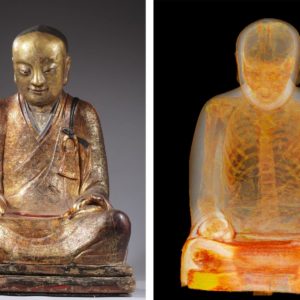
A 1,000-year-old statue of the Buddha was taken in for some restoration work when researchers made the incredible discovery that there was somebody inside.
The statue had been transported to Drents Museum in the Netherlands for some refreshment after 1,000 years when the mummified remains of a human being were discovered inside.
Putting the statue through a CT scan, they found that the monk’s organs had been removed and replaced with a series of paper scrolls.
On the scrolls were ancient Chinese characters, and the body was identified as that of Liuquan, a Buddhist master of the Chinese Meditation School.
He lived and died almost 1,000 years ago and it left researchers scratching their heads as to why his mummified remains had been placed within the statue.
One of the possible theories the team at Drents Museum explored was that Liuquan essentially mummified himself within the statue in an attempt to transform himself into a ‘living Buddha’.
After several years of this the monk would then be buried alive, breathing through a bamboo tube and ringing a bell to let others know he had not yet died.
Once the bell ringing stopped the tomb would be fully sealed and the body left in there for three years, and afterwards if the monk had been successfully mummified it would then be brought to a temple and venerated.
This was down to a spot of mistranslation and crossed wires which caused some confusion, as the mummified monk within the Buddha statue was found in the ‘lotus position vajra’.
The Buddha statue was given a CT scan to get a better look at the mummified monk inside. Credit: Drents Museum
The Buddha statue was given a CT scan to get a better look at the mummified monk inside. Credit: Drents Museum
Ganhugiyn Purevbata, founder and professor of the Mongolian Institute of Buddhist Art at Ulaanbaatar Buddhist University, said the position is meant to be a sign that the person is not dead, merely in a deep meditation.
However, the body inside the statue was very definitely dead despite the pose it was in and it’s likely that the good professor was speaking figuratively rather than actually saying the body within the statue was still alive.
Ganhugiyn Purevbata, founder and professor of the Mongolian Institute of Buddhist Art at Ulaanbaatar Buddhist University, said the position is meant to be a sign that the person is not dead, merely in a deep meditation.
However, the body inside the statue was very definitely dead despite the pose it was in and it’s likely that the good professor was speaking figuratively rather than actually saying the body within the statue was still alive.




